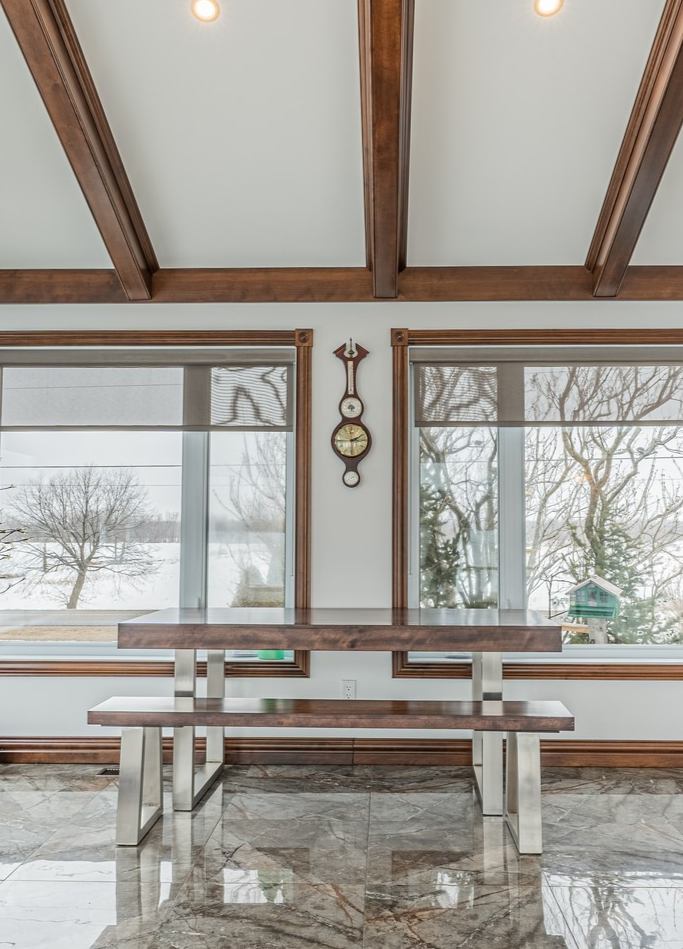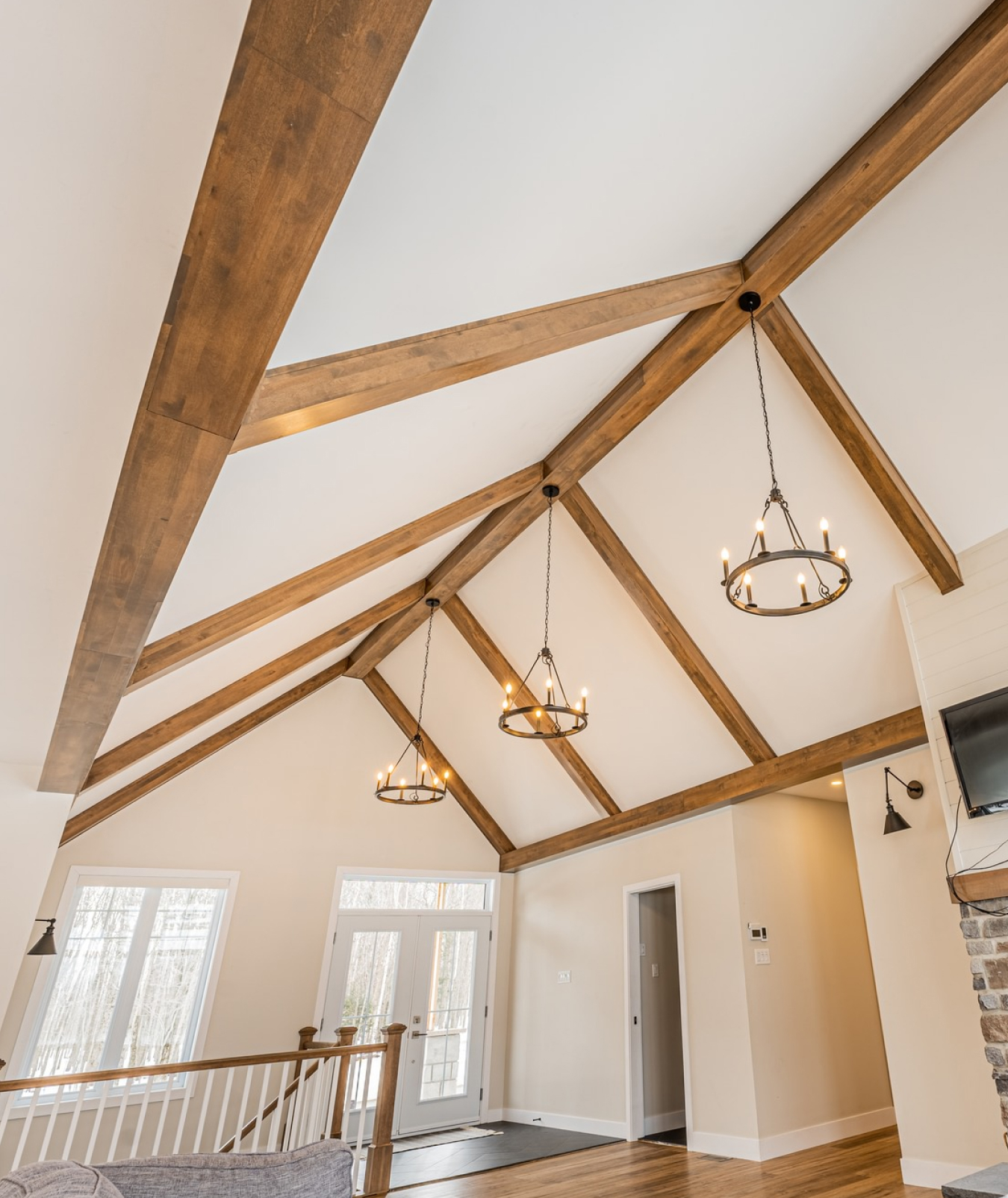Expert advice
We have prepared some tips and tricks to optimize your experience with the creations you entrust us with.
If, however, you would like to obtain further information regarding your project, do not hesitate to contact us to discuss it.

Hardwoods
With a greater density, hardwoods, also called noble woods, will be more robust and heavier than softwoods. They will therefore be favoured for projects where handling will be common and the risk of impacts higher.

Maple
Noble and hard, maple is not only the emblem of Canada, but also that of prestige and resistance in cabinetmaking projects. Its fine and homogeneous grain makes it an easy species to work with but due to its low resistance to temperature variations, we recommend not installing it near a heat source. Ideal for:
- Furniture
- Cutting boards
- Floors
- Mouldings
- Architectural products
- Kitchen
- Staircase
- Counter

Ash
In addition to being very robust, ash wood is flexible and tolerates temperature variations and higher humidity levels. Its smooth and permeable surface makes it an ideal species for painting or staining. However, this means that you will have to maintain it well as it stains easily without adequate protection. Not recommended for outdoor use. Very versatile, it lends itself to several projects, including:
- Stairs
- Furniture
- Bows
- Floor
- Kitchen

White Oak
Very resistant, white oak is known for its fine grain which makes it a flexible and easy wood to work with. Rot-proof, hence it is a species of choice for creations that will be exposed to bad weather. In the past, it was also used for building boats. We recommend it for:
- Furniture
- Floors
- Mouldings
- Architectural products
- Doors
- Boats
- Barrel
- Staircase

Yellow Birch
Semi-hard cherry is highly prized for its cream colour with reddish accents. However, it does not tolerate humidity, so its use is reserved for interior projects where the risk of contact with water is lower. We will use it for:
- Interior trim
- Furniture
- Cabinets
- Wood turning
- Staircase
- Floor
- Counter

Cherry Tree
This wood has a straight and fine grain. It is distinguished by its reddish-amber hue. Very easy to work with, it allows for beautiful finishing work. However, it cannot withstand humidity so it should be avoided for bathrooms and outdoor uses. It is very appreciated in the manufacture of:
- Furniture
- Staircase
- Kitchen
- Moulding

Black Walnut
Due to its fine grain and dark colour, this wood is ideal for creating a contrast effect with another species – black walnut is very popular in high-end cabinetmaking.
However, it does not have good resistance to external conditions. It is mainly used for:
- Furniture
- Architectural cabinetmaking
- Marquetry
- Moulding
- Staircase
- Counter
Softwood
Softer and malleable, softwoods are, with a few exceptions, less resistant than hardwood. However, they should not be underestimated; they also have their advantages, notably their lightness and economical price.

White Pine
White pine is very appreciated for its fine and straight grain which gives it a uniform texture and appearance. Note that its colour will tend to darken over time. Moderately resistant to rot, white pine is not recommended for exterior projects. We will rather favour it for:
- Panelling
- Floors
- Furniture
- Panels
- Doors
- Windows
- Cabinets
- Structure
- Mouldings

White Cedar
Rot-proof, white cedar is ideal for objects intended for outdoor use. Its uniform grain and malleability make it very practical to work with using different techniques. Its soft surface and lightness make it an essence of choice for various everyday applications. Cedar paints very well, but if it is not treated, it will display a gray tint over time which can be much appreciated for its rustic appearance. This species is recommended for:
- Exterior covering
- Shingles
- Patios
- Veranda
- Mouldings
- Indoor and outdoor furniture
- Docks
- Doors
- Windows

Larch
Larch is both rot-proof and waterproof. It is the most resistant softwood there is and its colour contrast to create an elegant effect which makes it very popular for:
- Moulding and rosettes
- Floors
- Decking
- Panelling
- Indoor and outdoor furniture
- Exterior covering

Hemlock
Soft and light, hemlock wood is easy to work with. It will be especially useful for the non-visible element of your projects. We will use it for:
- Plywood,
- Vertical exterior panelling
- Structures
- Boards
- Carpentry
Different approaches for a unique product
Our passion for wood is not limited to traditional cabinetmaking. We constantly seek to push our limits to offer you a product that stands out from the crowd.
Which products to use?
An eco-responsible selection
As in all aspects of its corporate culture, Toosky values ethics and sustainability when it comes to choosing its products.
Colour focus
Whether it’s about health, finish, durability, or practicality, we always favour wood stain for colouring. Since solvent emissions are harmful to both you and us, we believe the best choice lies in water-based and oil-based stain.
Why choose the water-based wood stain?
- A more natural finish
- Good resistance to damage
- Easier maintenance (no more solvents and stripping)
- Less harmful to your health and ours
- Significantly, lower environmental impacts
Protection focus
We prioritize Livos and Rubio oils, as well as water-based lacquers which, in addition to being more eco-responsible, are easy to maintain. We also use milk paint as it is possible to create cracked and worn-out effects with it.
When we turn to varnishes and lacquers, whether water or solvent based, we choose products with a catalyst for increased durability.
Some other products we use

Lite-N-Up wood bleach
A two-component product that, once mixed, whitens the wood.

Aluminum Oxide
If we must varnish floors or a staircase, we will choose one with aluminum oxide to offer superior resistance to other types of varnish available on the market.

Epoxy
We use epoxy to fill imperfections in the wood when desired. This low-porosity product can easily accept most finishes.

Shellac
We currently use this line of shellac, which comes in flakes that we dissolve in pure alcohol before applying it as a wood finish.
How to maintain
my wooden furniture?
Another perfect example of where the expression ‘Less is more’ truly applies. There’s no need for an arsenal of so-called wood care products. A non-abrasive cloth and some soapy water do the job perfectly, at a lower cost both economically and environmentally.
